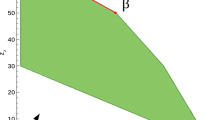Abstract
In this paper we consider the multidimensional binary vector assignment problem. An input of this problem is defined by m disjoint multisets \(V^1, V^2, \ldots , V^m\), each composed of n binary vectors of size p. An output is a set of n disjoint m-tuples of vectors, where each m-tuple is obtained by picking one vector from each multiset \(V^i\). To each m-tuple we associate a p dimensional vector by applying the bit-wise AND operation on the m vectors of the tuple. The objective is to minimize the total number of zeros in these n vectors. We denote this problem by
 , and the restriction of this problem where every vector has at most c zeros by
, and the restriction of this problem where every vector has at most c zeros by
 .
.
 was only known to be
was only known to be
 -hard, even for
-hard, even for  . We show that, assuming the unique games conjecture, it is
. We show that, assuming the unique games conjecture, it is  -hard to
-hard to  -approximate
-approximate
 for any fixed
for any fixed
 and
and
 . This result is tight as any solution is a
. This result is tight as any solution is a
 -approximation. We also prove without assuming UGC that
-approximation. We also prove without assuming UGC that
 is
is
 -hard even for
-hard even for
 . Finally, we show that
. Finally, we show that
 is polynomial-time solvable for fixed
is polynomial-time solvable for fixed
 (which cannot be extended to
(which cannot be extended to
 ).
).




Similar content being viewed by others
Notes
i.e.admits an algorithm in
 for an arbitrary function f.
for an arbitrary function f.Incriminated problems are
 and
and

References
Alimonti P, Kann V (2000) Some APX-completeness results for cubic graphs. Theor Comput Sci 237(1–2):123–134
Bansal N, Khot S (2010) Inapproximability of hypergraph vertex cover and applications to scheduling problems. In: International Colloquium on Automata, Languages and Programming (ICALP), pp 250–261
Crescenzi P (1997) A short guide to approximation preserving reductions. In: Proceedings of the twelfth annual IEEE conference on computational complexity, Ulm, Germany, June 24–27, 1997, pp 262–273
Dokka T, Bougeret M, Boudet V, Giroudeau R, Spieksma FC (2013) Approximation algorithms for the wafer to wafer integration problem. In: Approximation and online algorithms (WAOA). Springer, pp 286–297
Dokka T, Crama Y, Spieksma FC (2014) Multi-dimensional vector assignment problems. Discrete Optim 14:111–125
Duvillié G, Bougeret M, Boudet V, Dokka T, Giroudeau R (2015) On the complexity of wafer-to-wafer integration. In: International conference on algorithms and complexity (CIAC), pp 208–220
Papadimitriou C, Yannakakis M (1988) Optimization, approximation, and complexity classes. In: Proceedings of the twentieth annual ACM symposium on theory of computing. ACM, pp 229–234
Reda S, Smith G, Smith L (2009) Maximizing the functional yield of wafer-to-wafer 3-d integration. IEEE Trans Very Large Scale Integr VLSI Syst 17(9):1357–1362
Vazirani VV (2001) Approximation algorithms. Springer, Berlin
Author information
Authors and Affiliations
Corresponding author
Additional information
This work is supported by the Interuniversity Attraction Poles Programme P7/36 \(\ll {\hbox {COMEX}} \gg \) initiated by the Belgian Science Policy Office.
Rights and permissions
About this article
Cite this article
Bougeret, M., Duvillié, G. & Giroudeau, R. Approximability and exact resolution of the multidimensional binary vector assignment problem. J Comb Optim 36, 1059–1073 (2018). https://doi.org/10.1007/s10878-018-0276-8
Published:
Issue Date:
DOI: https://doi.org/10.1007/s10878-018-0276-8





 for an arbitrary function f.
for an arbitrary function f. and
and
